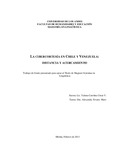Mostrar el registro sencillo del ítem
La cibercortesía en Chile y Venezuela: distancia y acercamiento
| dc.rights.license | http://creativecommons.org/licenses/by-nc-sa/3.0/ve/ | |
| dc.contributor.advisor | Álvarez Muro, Alexandra | |
| dc.contributor.author | César V., Yalena Carolina | |
| dc.date.accessioned | 2013-02-27T15:27:44Z | |
| dc.date.available | 2013-02-27T15:27:44Z | |
| dc.date.issued | 2013-02-27T15:27:44Z | |
| dc.identifier.uri | http://www.saber.ula.ve/handle/123456789/36664 | |
| dc.description.abstract | Este estudio describe, en forma contrastada, el uso de la atenuación como estrategia de cortesía por parte de estudiantes y profesores universitarios chilenos y venezolanos cuando intercambian correos electrónicos. Un total de 52 correos electrónicos fueron enviados por 8 mujeres y 8 hombres de Venezuela, y 8 mujeres y 8 hombres de Chile. Los recursos de atenuación fueron categorizados de acuerdo al nivel en el cual actúan: la locución, la ilocución y el origen del enunciado. El análisis de los datos reveló que, en ambos países, tanto los hombres como las mujeres emplean recursos para atenuar la intención de sus mensajes; sin embargo, los venezolanos de ambos géneros emplearon más recursos de atenuación que los chilenos. En Venezuela, las mujeres superaron a los hombres en el empleo de los recursos de atenuación. Creemos que, al mostrar más de su individualidad, las mujeres crean barreras discursivas para defender su imagen de autonomía y disminuyen las distancias sociales entre ellas y sus interlocutores. En Chile, los hombres superaron a las mujeres en el empleo de recursos de atenuación. Creemos que los hombres tienden a atenuar más porque el grado de imposición de sus mensajes es mayor que el de las mujeres. Asimismo, creemos que los venezolanos atenúan en mayor proporción que los chilenos porque las distancias sociales entre los interlocutores se disminuyen fácilmente en algunos contextos. En Chile, por el contrario, los emisores y receptores están más conscientes de las distancias sociales y las respetan. Estos hallazgos, nos permiten concluir, por un lado, que la cultura y el género intervienen en la diferencia de frecuencia de uso de la atenuación en ambos países. Por otro lado, se corrobora la tesis de que a menor distancia entre los interlocutores, mayor es el peligro de ser invadido; en esos casos, se requiere un mayor uso de la atenuación. | es_VE |
| dc.description.sponsorship | Universidad de Los Andes | es_VE |
| dc.language.iso | es | es_VE |
| dc.rights | info:eu-repo/semantics/openAccess | |
| dc.subject | correo electrónico | es_VE |
| dc.subject | atenuación | es_VE |
| dc.subject | género | es_VE |
| dc.subject | cortesía | es_VE |
| dc.subject | cultura | es_VE |
| dc.title | La cibercortesía en Chile y Venezuela: distancia y acercamiento | es_VE |
| dc.type | info:eu-repo/semantics/masterThesis | |
| dc.description.abstract1 | This study describes the differentiated use of attenuation as a politeness strategy by Chilean and Venezuelan college teachers and their students when they exchange e-mails. A total of 52 e-mails were exchanged: 26 between 8 Venezuela women and 8 Venezuela men, and 26 between 8 Chilean women and 8 Chilean men. The attenuation resources were categorized according to the attenuation level which they addressed: locution, illocution and origin of the message. The analysis of the data revealed that, in both countries, both men and women use resources to soften the intention of their messages; however, Venezuelans of both genders used more attenuation resources than their Chilean counterparts. On the one hand, in Venezuela, women outnumbered men in the use of attenuation resources. We believe that, as women show more of their personalities, they tend to create discursive barriers to defend their image of autonomy and reduce the social distance between them and their interlocutors. On the other hand, in Chile, men outnumbered women in the use of attenuation resources. We believe that men tend to attenuate more because the level of demand of their messages is higher than that of women. Also, we believe that Venezuelans attenuate more than Chileans because in Venezuela the social distance between interlocutors is often reduced in academic contexts. For its part, in Chile, interlocutors are more aware of social distances and respect them more often. These findings allow us to conclude that culture and gender influence the amount and frequency of attenuation in both countries. Likewise, we confirm the assumption that the smaller the social distance between interlocutors, the greater the risk of having their spaces invaded, which leads them to a greater use of attenuation. | es_VE |
| dc.description.grado | Maestría | es_VE |
| dc.publisher.pais | Venezuela | es_VE |
| dc.subject.facultad | Facultad de Humanidades y Educación | es_VE |
| dc.subject.keywords | attenuation | es_VE |
| dc.subject.keywords | courtesy | es_VE |
| dc.subject.keywords | culture | es_VE |
| dc.subject.keywords | es_VE | |
| dc.subject.keywords | gender | es_VE |
| dc.subject.postgrado | Maestría en Lingüística | es_VE |
| dc.subject.thematiccategory | Artes y Humanidades | es_VE |
| dc.subject.tipo | Tesis | es_VE |
| dc.type.media | Texto | es_VE |


